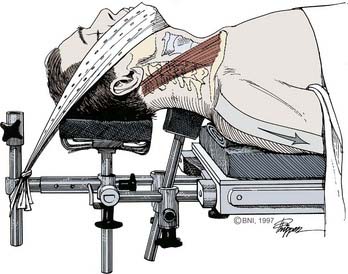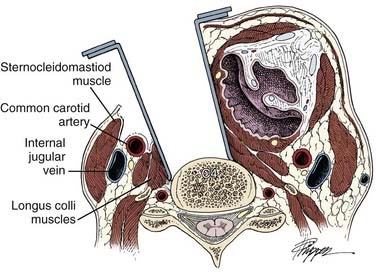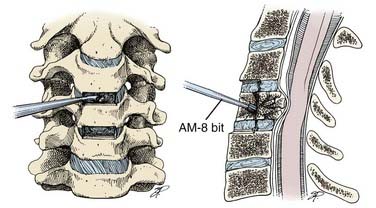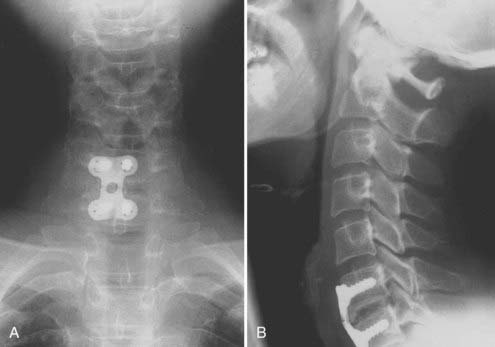CHAPTER 297 Anterior Cervical Instrumentation
Pathologic processes that compromise the biomechanical integrity of the cervical spine ultimately require management that incorporates rigid internal fixation of the vertebral column. The application of anteriorly based screw-plate systems to facilitate reconstruction of the cervical spine is a relatively recent innovation in the history of spinal surgery and has evolved during the last 20 years. This instrumentation confers immediate segmental stability along the vertebral column and ensures patient compliance by locating the orthosis internally. Its use has been associated with improved fusion and postoperative comfort;1 those who receive the implants tend to return to work more rapidly than patients who do not.2–8 Consequently, anterior cervical screw-plate systems have become an integral part of the surgical armamentarium for achieving vertebral interbody arthrodesis within the subatlantal (C2-C7) cervical spine after procedures involving diskectomy or corpectomy. The past 2 decades have witnessed an intense evolution within this domain of instrumentation, and several anterior cervical screw-plate systems are commercially available. In pursuing the clinical ideal of product versatility, enhanced fusion rates, and ease of application, each new generation of anterior plating system has built on the growing body of biomechanical research and clinical experience. Aggressive advertising espouses the relative benefits of these individual systems.
Indications for Anterior Cervical Screw-Plate Fixation
Anteriorly directed decompressive procedures for the subaxial cervical spine can be performed without grafting material (simple diskectomy), with grafting material (fusion procedure), and with graft material augmented by screw-plate instrumentation (fusion and internal fixation). Even without the placement of grafting material (simple diskectomy), spontaneous interbody arthrodesis is frequently observed. Clinical results reported by the senior author (VKHS) attest to the efficacy of the simple diskectomy procedure in younger patients characterized preoperatively by normal cervical lordosis, stable flexion and extension plain radiographs, absence of significant axial (neck) pain, and degenerative disease limited to one or two levels.9
The rationale for performing internal fixation and fusion of the subaxial cervical spine can be distilled as follows: to restore stability to the structurally compromised spine, to maintain alignment after correction of a deformity, to prevent progression of a deformity, and to alleviate pain.10 Degenerative, neoplastic, infectious or inflammatory, traumatic, and iatrogenic (postsurgical) causes of vertebral column instability, with or without concomitant neural compression, are well-suited for treatment with rigid internal fixation from an anterior surgical approach. Anterior cervical plates function to optimize the environment for osseous union by providing immediate rigid fixation across the span of desired arthrodesis. Internal fixation with screw-plate systems is performed solely in conjunction with a grafting procedure. The proximity of this instrumentation to the fusion substrate functions to resist graft displacement or disruptive micromotion at the graft-vertebral body interface and frequently obviates the need for postoperative bracing with an external orthosis in most cases.
At our institution, absolute criteria for cervical plate instrumentation include procedures that involve any extent of formal corpectomy or patients with posttraumatic spinal instability. In the event of a particularly severe (three-column) injury,11 an isolated anterior construct might not impart sufficient stabilization. In this circumstance, the addition of a posterior fixation procedure (circumferential fusion) to reconstruct the posterior tension band or the use of a rigid external orthosis would be necessary.12–15 Anterior instrumentation and fusion procedures are now routinely performed after any number of levels of anterior cervical discectomy.16–18
Individual patient characteristics can adversely affect the anticipated success of bone healing and provide relative indications for incorporating internal fixation in the operative strategy. Malnutrition, the active use of tobacco, the presence of significant osteoporosis or other disorders that result in poor bone quality, the need for exogenous steroids, and a history of previously unsuccessful fusion efforts (at the same or different vertebral levels) are relative indications for an anterior cervical plate.19,20
Operative Technique
Preoperative Preparation and Positioning
After informed consent for the surgical procedure has been obtained, patients are brought to the operating room wearing antiembolic stockings. Intravenous and intra-arterial access are secured, and a single prophylactic dose of antibiotic is administered 30 minutes before the skin is incised. In patients with evidence of myelopathy or significant compromise of the vertebral canal, baseline evoked potentials (somatosensory and motor) are measured before the patient is intubated or positioned. Muscle relaxants are avoided during surgery to provide an immediate indication of neural irritation. Patients with posttraumatic cervical instability or preexisting myelopathy undergo fiberoptic or awake intubation with the surgeon in attendance. Patients with preexisting myelopathy may receive methylprednisolone in accordance with the NASCIS III protocol immediately before the procedure begins.21 Drug infusion is continued throughout the procedure and is discontinued after surgery when the patient’s neurological examination is stable. A urinary catheter is placed after general anesthesia is induced if the procedure is anticipated to exceed 3 hours. When patients are positioned, bony and soft tissue prominences are carefully padded to prevent pressure sores or peripheral neuropathies.
Before surgery patients are counseled regarding the choice of autograft or allograft for their fusion substrate. Given the slightly lower but comparable rate of anterior cervical fusion using fibular allograft instead of autograft (particularly for single-level procedures) and the opportunity to prevent the complications associated with harvesting a tricortical segment of autologous iliac crest, most of our patients choose an allograft fusion procedure.20,22 Among the choices for allograft sources, we prefer fibular allograft given its greater compressive strength compared with tricortical iliac crest allograft.6,20,23,24 An alternative to bone grafts is now available with the emergence of polyetheretherketone (PEEK) implants, which are associated with fusion rates similar to those of bone grafts when used in conjunction with the correct dose of recombinant human bone morphogenic protein-2 placed inside the implant.25
Reported donor site complications after autologous iliac crest harvest include acute and chronic pain, infection, arterial hemorrhage, peripheral nerve injury, pelvic instability, cosmetic deformity, hernia formation, and postoperative hematoma.26 The risk of transplanting HIV-infected bone has been estimated at less than 1 in 1 million when stringent screening criteria are used.6,24,27 If an autograft is to be harvested from the iliac crest, the appropriate hip is elevated with a towel roll. Patient preference determines the side from which the autograft is removed. An intrascapular roll, tape along the lateral aspect of the arms, and soft wrist ties that can be manipulated by the circulating nurse are helpful adjuncts that facilitate intraoperative radiographic visualization of the distal vertebral column.
We prefer the Caspar head holder (Aesculap, Center Valley, PA) to support the patient’s head and cervical spine (Fig. 297-1). The head is maintained in a neutral position, and the neck is maintained neutrally or is extended minimally with the assistance of a chin strap. The evoked potentials should be observed carefully for any changes, and intraoperative fluoroscopy should be available to confirm the maintenance of cervical alignment (anatomic or best attainable) after positioning is completed. At our institution, the convenience and cost-effectiveness of using cross-table fluoroscopy from the beginning of the procedure are well-established compared with the relative expense and delays associated with obtaining intraoperative plain film radiographs. The importance of fluoroscopy in confirming the operative level, selecting an appropriately sized cervical plate, directing screw trajectories, assessing final screw positions, and evaluating plate alignment relative to the vertebral column cannot be overstated.
Skin Incision
The operative approach is directed from the side that is most comfortable for the surgeon and usually corresponds to the patient’s right side in a right-handed surgeon. It was thought that the recurrent laryngeal nerve is more susceptible to injury given its relatively anterolateral course outside the tracheoesophageal groove when compared with the left side.28 Consequently, some surgeons may prefer an approach directed from the patient’s left side. However, injury to the thoracic duct has been reported as a complication of approaching the caudal cervical spine from the left side.29 Studies have shown that there is no difference in the incidence of recurrent laryngeal nerve injury associated with a right- or left-sided approach.30,31 If the patient has already undergone a cervical procedure, we pursue operative access from the ipsilateral side. Although this strategy requires contending with scar tissue and altered anatomic planes, it avoids the more daunting possibility of incurring bilateral injury to vagal nerve branches, the unilateral manifestations of which may be subtle and otherwise undetected unless specifically evaluated for after the previous procedure. If a contralateral approach to a previous scar is pursued, we recommend that the patient undergo preoperative examination of the vocal cords by an otolaryngologist to avoid the possibility of bilateral injury to vagal nerve branches.
A general orientation along the cervical spine can be estimated by external anatomic landmarks (Fig. 297-2), but intraoperative fluoroscopy ensures a more precise placement of the skin incision and limits the amount of soft tissue dissection necessary to obtain adequate visualization of the targeted segment of the vertebral column. Preoperative use of the fluoroscope to define the most rostral and caudal levels of exposure necessary for decompression and stabilization also assists in selecting the optimal orientation for the incision. We have found that a transverse incision located within a skin crease is cosmetically superior to a longitudinal incision that follows the medial border of the sternocleidomastoid muscle. When extended adequately (beyond the midline and laterally across the sternocleidomastoid muscle) and accompanied by generous undermining of the platysma muscle, a transverse incision rarely fails to provide sufficient access and visualization to enable multiple corpectomies to be performed with an accompanying fusion and plating procedure. However, the longitudinal incision may be more functional in patients with difficult anatomy or in whom a particularly long fusion construct is required.
Soft Tissue Dissection and Exposure of the Vertebral Column
After the patient has been prepared and draped, the skin is sharply incised to the level of the platysma muscle. Hemostasis is obtained with electrocauterization, and the platysma layer is traversed or split longitudinally. Early attention to broad undermining of this subcutaneous muscle is greatly rewarded by the rostral and caudal extents of surgical exposure that can be attained. The underlying sternocleidomastoid muscle and tracheoesophageal bundle are identified, and the avascular plane between these structures is developed with careful, blunt dissection. A trajectory medial to the carotid sheath is followed, and the underlying vertebral column is palpated (Fig. 297-3). Comparing the osteophytic topography to preoperative or intraoperative radiographs can often help orient the surgeon along the cervical column, but fluoroscopy is used for definitive localization along the cervical spine. The prevertebral fascia is opened, and the ventral aspect of the anterior longitudinal ligament is cleaned of overlying soft tissue. The medial insertions of the longus colli muscles are elevated bilaterally from the vertebral column.
Several self-retaining retractor systems are available for enhancing exposure of the anterior vertebral column. Fundamental to all of these retractors is the requirement to seat their laterally directed blades deep to the longus colli musculature to prevent injury to the adjacent tracheoesophageal bundle or carotid artery. Injury to the vagal innervation of the larynx can result in silent aspiration (superior laryngeal branch) or hoarseness (recurrent laryngeal nerve). Apfelbaum and Kriskovich8 have reported that injury to the recurrent laryngeal nerve during anterior cervical surgery is most likely because of compression of the endolaryngeal segment of this nerve against the shaft of the endotracheal tube after the retractor is placed rather than direct injury from dissection. To protect against this neuropraxia, they describe transiently deflating the cuff of the endotracheal tube after placing the self-retaining retractors and then reinflating the cuff to “just seal” pressure. This allows the endotracheal tube to recenter within the larynx and remove pressure from the laryngeal wall. This technique improved the incidence of injury to the recurrent laryngeal nerve, which decreased from 6.4% in 250 patients undergoing anterior cervical plating without this maneuver to 1.7% of the next 650 consecutive patients in whom it was used.
Rostral-caudal exposure can be improved by placing a second retractor perpendicular to the first (Fig. 297-4). Use of the high-speed drill to remove obstructing osteophytes, in conjunction with the superior illumination and magnification offered by the surgical microscope, has significantly diminished the amount of active cervical distraction necessary to confirm adequate neural decompression during a diskectomy procedure. Distraction posts are usually inserted in the vertebrae to improve exposure of the disk space during decompression of the spinal cord and neural foramina. Alternatively, some surgeons maintain vertebral distraction by placing patients in axial traction using Gardner-Wells tongs at the start of the procedure32 or through gentle, even traction applied by the anesthesiologist during graft impaction. If the patient is maintained in tongs during the procedure, it is crucial to remember to release this distraction after the grafting material has been inserted and before the fixation hardware is placed.
Discectomy With or Without Corpectomy
Once orientation at the level of pathology has been confirmed, annulotomies are performed and superficial diskectomies are initiated with straight and angle curets (Fig. 297-5A). If an interval corpectomy is necessary, a bone rongeur can be used to resect the anterior half of the vertebral body and the Midas Rex drill (Medtronic, Memphis, TN.) used to complete the deeper aspect of bone removal (Fig. 297-5B). If placement of an allograft strut (fibular) is planned, autologous bone from the vertebrectomy site is saved for packing the hollow center of the allograft shaft. The operative microscope is routinely used to assist with the removal of deeper bone and soft tissues to facilitate safe exposure of the dura. The epidural space is inspected, and posteriorly based osteophytes are removed from the vertebral bodies and foramen to ensure adequate decompression of the spinal cord and nerve roots. Where possible, generous diskectomies are substituted for a corpectomy if adequate neural decompression can be achieved through wide and deep undercutting of the offending posterior vertebral body surfaces. The benefits of avoiding a complete corpectomy include preserving additional sites for screw fixation along the plate and circumventing the higher risk of nonunion or hardware failure that accompanies fusion constructs involving multiple corpectomy segments.33,34 This latter point is particularly relevant for patients who require multilevel decompressions.
When completed, the typical lateral extent of tissue removed for diskectomies or corpectomies spans up to 18 to 20 mm. Reliable identification of the vertebral midline is crucial to ensure adequate decompression of neural tissue and to prevent vascular complications related to injury of the vertebral artery.35–37 Frequently, severe degenerative disease, traumatic disruption, or scarring from previous surgical procedures result in the loss of the otherwise apparent anatomic midline. Typically, however, several anatomic cues remain and can be used to provide orientation to the midline for both decompressive maneuvers and plate positioning (Table 297-1). Marking the midline of the vertebral bodies with monopolar cauterization before the longus colli muscles are elevated can also provide helpful reference as the procedure progresses. It is also worthwhile to confirm with the anesthesiologist that the patient’s head has not deviated from the midline position established at the beginning of the case.
TABLE 297-1 Anatomic Cues Available for Maintaining Midline Orientation
| Location of longus colli muscles |
| Location of uncovertebral joints |
| Curvature of vertebral body (lateral margin/waist) |
| Location of epidural veins and fat |
| Curvature of dural tube |
| Visualization of nerve roots |
| Palpation of pedicles |
| Location of sternomanubrial notch (angle of Louis) |
| Use of anteroposterior fluoroscopy (pedicle/spinous process location) |
From Baskin JJ, Vishteh AG, Dickman CA, et al. Techniques of anterior cervical plating. Oper Tech Neurosurg. 1998;1:90-102.
Bone Grafting and Plate Fixation
Screw-plate application provides immediate rigid fixation of the cervical spine and functions analogously to an internal halo brace. By ideally imparting some combination of load bearing to the vertebral column and load-sharing properties through the graft site, plating systems protect the neural elements from trauma while facilitating the development of a fusion response, respectively. Bone and instrumentation deform and reform as stress is applied.38 Over time, even the most rigid constructs permit some segmental motion across the site of fixation. In the absence of an osseous union, repetitive loading will fatigue an implant to the point of failure through loosening or breakage. Consequently, perhaps the most fundamental principle related to performing rigid internal fixation is that the presence of instrumentation does not substitute for a carefully conceived and meticulously prepared fusion site.39,40 In the absence of an associated arthrodesis, hardware failure is a time-dependent certainty (Fig. 297-6).
We typically use the Robinson-Smith technique for interbody fusion after a cervical diskectomy.41 Techniques to optimize the chances for successful arthrodesis (Table 297-2) at the operative site can be subdivided into those that (1) enhance the natural capacity for bone healing to occur, (2) minimize the extent of iatrogenically induced impediments to bone graft incorporation, and (3) maximize the biomechanical advantage of the hardware construct.
TABLE 297-2 Techniques to Optimize Fusion-Hardware Construct
| MANEUVER | BENEFIT |
|---|---|
| Insert graft under compression. | Improves graft incorporation |
| Maximize surface of implant-bone interface. | Improves graft incorporation |
| Remove soft tissue from fusion interface. | Avoids fibrous healing |
| Maintain integrity of cortical end plate. | Prevents telescoping of graft |
| Irrigate while drilling. | Prevents thermal injury with impaired bone healing/resorption |
| Avoid contouring plate. | Prevents fatiguing of implant |
| Avoid overtightening screws. | Prevents stripping screw hole and diminishing bone purchase |
| Insert angulated screws. | Improves pull-out strength |
| Use longest screws possible. | Improves pull-out strength |
From Baskin JJ, Vishteh AG, Dickman CA, et al. Techniques of anterior cervical plating. Oper Tech Neurosurg. 1998;1:90-102.













